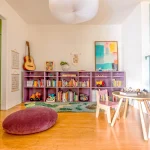
Contemporary residential architecture emphasizes simplicity, utility, and authenticity – three Modernist ideals that formed in the 19th century.
Smart home technology is changing the way our homes are designed, giving homeowners the ability like never before to control their environments to suit their needs, and giving them more independent freedom to live the way they want.
Advanced design and planning
Technology is helping the designers in selling the idea to the client (they can see the real product via the technology, whereas with imagination only they might come up with something wrong).It Is also helping us to reduce the amount of mis-communication involved with the design and reduction of misunderstanding it can bring (even with the best intention you sometimes fail to communicate it clear).We have also had advancements in virtual and augmented reality (VR/AR).A company called Ambika Housing, for example, is providing a VR/AR tour to give the potential homeowners an accurate tour of their potential homes even before construction begins! Now the home buying process is more simplified than before (simple is good).
The development of advanced home design also aids in designing more energy-efficient and environmentally friendly homes. Using recycled materials to ensuring intelligent building software which predicts energy usage while designing it, these design old and new go hand in hand and beyond to aid in designing homes that are functional to live and look great on both sides.
Innovative construction materials and methods
With a view to decrease the environmental footprint of contemporary homes, innovative building materials and contemporary construction methods will become a distinguishable element of modern home design. Using renewable energy sources to create sustainable and environmentally-friendly homes and buildings will require innovative planning, engineering practices and eco-friendly materials.
Such an innovative approach will also be employed in the construction of flat roofs so as to allow solar power systems on the roofs of newly-built homes.
Bamboo reeds and even entire stems can be used in place of wood as one type of energy-saving material. Another option here might be other repurposed, recycled or otherwise alternative building materials, such as reclaimed lumber from a recycling programme, plant-based polyurethane rigid foam derived from biomass resources such as corn, and even bricks made out of cigarette butts (aimed at helping to prevent this form of litter).
Other cutting-edge building materials include sound-reducing construction materials and permeable pavement technologies that allow water to permeate the surface of a road rather than run off. Open floor plans and generous windows are increasingly embraced in new homes, helping to erode the boundaries between living inside and out.
Smart home technology
As a result of emerging smart technologies, home design is undergoing great changes. Many appliances in the home can now help the owners cut down on energy us and save money at the same time. Furthermore, with sensors and intelligent automation, fewer carbon emissions can be produced to lead a more eco-friendly life.
For instance, IoT and artificial intelligence (AI) technologies make smart home devices a kind of intercommunicative ecosystem capable of responding to your lifestyle, whether you want them to – perhaps your smart thermostat automatically adjusts its temperature setting, or your smart light turns on in response to how bright the day is.
Smart technology developers are giving homeowners the power to integrate functionality without disrupting the flow or attractiveness of a house. Mark Sinclair, a security specialist based in California, has mentioned one company called Level, whose smart locks look no different from traditional deadbolts and can be easily retrofitted into houses built before the smart-home revolution. IoT-enabled devices can extend wireless networks and work even when the power goes out or you’re out of town – great ideas for the families with elderly relatives or people who travel constantly.
Virtual reality and augmented reality
In the field of home design, virtual and augmented reality has started to be used more often by designers in order to communicate ideas to their clients. This has the advantage of being more understandable and expressive than a simple 2D blueprint, or even a 3D rendering.
By laying flat, digital representations of paint colours, wallpaper and window treatments over what you see through your smartphone, AR apps can help homeowners better plan and visualise changes to their living space — reducing the chances of experiencing sticker shock or disappointment after completing costly changes to their home.
VR goes one step further by placing people directly into a simulated world, and now, as building teams can show clients what the redesigned space will look like before any work has been done, and remove uncertainty and build confidence in the final product, these individualised residences are the ultimate expression of a haven that combines technology with unique requirements to suit a family lifestyle. Whether it’s playing badminton in the living room, having a seat in a soundproof box or charging your electric car in the garage, the modern home really is your companion






